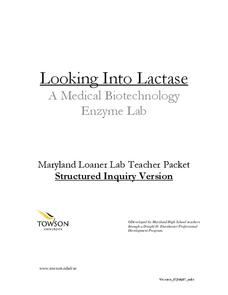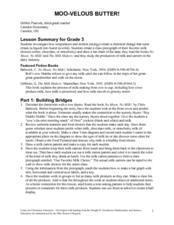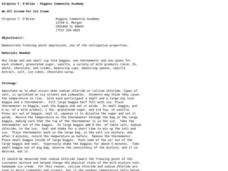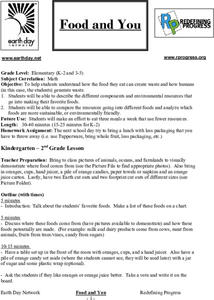Curated OER
Observation Milk Fat Lesson
Turn your class loose to experiment with the different fat content in skim milk, whole milk, half and half, and heavy cream. This is a visually vibrant experiment, as learners drip food coloring on the surface of the products and measure...
Curated OER
Milk and Dairy, Day 1
Students review different types of milk products and their characteristics, demonstrate how to select and prepare milk and milk products, identify standard serving sizes, define terms associated with milk and milk products, and practice...
Curated OER
Keeping Milk Fresh
Young scholars identify the risks of spoilage and pathogens in fresh milk. They investigate the farmer's role in keeping milk safe to drink and identify safety procedures used in dairy farming.
Towson University
Looking Into Lactase: Structured Inquiry
Why is lactase important? Biology scholars explore enzyme function in a structured inquiry lab. The activity tasks lab groups with observing how temperature and pH affect enzyme activity, as well as determining which milk products...
Curated OER
Name That Cheese!
Students explore a variety of cheese. In this cheese lesson plan, students sample 4 different cheeses produced from cow's milk and recorded their observations about the cheeses prior to identifying them.
Curated OER
Graphing Dairy Production Statistics
Students collect data about dairy production. In this geometry lesson, students formulate and model problem solving. They collect data and plot it on a graph.
Curated OER
Moo-Velous Butter!
Third graders investigate how temperature and motion (energy) create a chemical change that turns cream ( a liquid) into butter (a solid). They create a class pictograph of their favorite mils choices (white, chocolate, or strawberry)...
Curated OER
We All Scream for Ice Cream
Students investigate the freezing point depression of water while making ice cream. In this colligative properties lesson plan, students make ice cream using ice, salt and water to freeze milk and sugar. They measure the temperature of...
Curated OER
THE FABLE OF THE FAINTING GOATS
Students practice telling time while reading a story about a fainting goat. They write their own story about a fainting goat. Students write letters to the International Fainting Goat Association, asking for more information about...
Curated OER
Microbe Experimentation
Seventh graders study microorganisms in their environments by experimenting with milk products. In this microbes lesson, 7th graders read background information about microorganisms in yogurt and soured milk. Students then follow a...
Curated OER
TIN CAN TREAT
Students conduct an experiment where they will change a liquid dairy product into a solid. They review the definitions of liquids and solids. Students are given an example of each. They are divided into groups of four, each group is...
Curated OER
Alkaline-Earth Metals
Learners study the importance of alkaline earth metals. In this metals lesson students research the minerals that are essential for human health.
Curated OER
Composting
Learners discover the concept of decomposition. They examine how it makes the soil more fertile and how it helps plants. They put a compost bin in their backyard and record their observations.
Curated OER
Get Fit for Yosemite - Nutrition
Learners demonstrate an understanding of healthy eating habits and of following a fitness program. They visit Yosemite Institute.
Curated OER
Food and You
Students examine the types of foods they eat. They describe the different components and resources that go into making their favorite foods. They also compare the resources going into different foods and identify ones which are more...
















